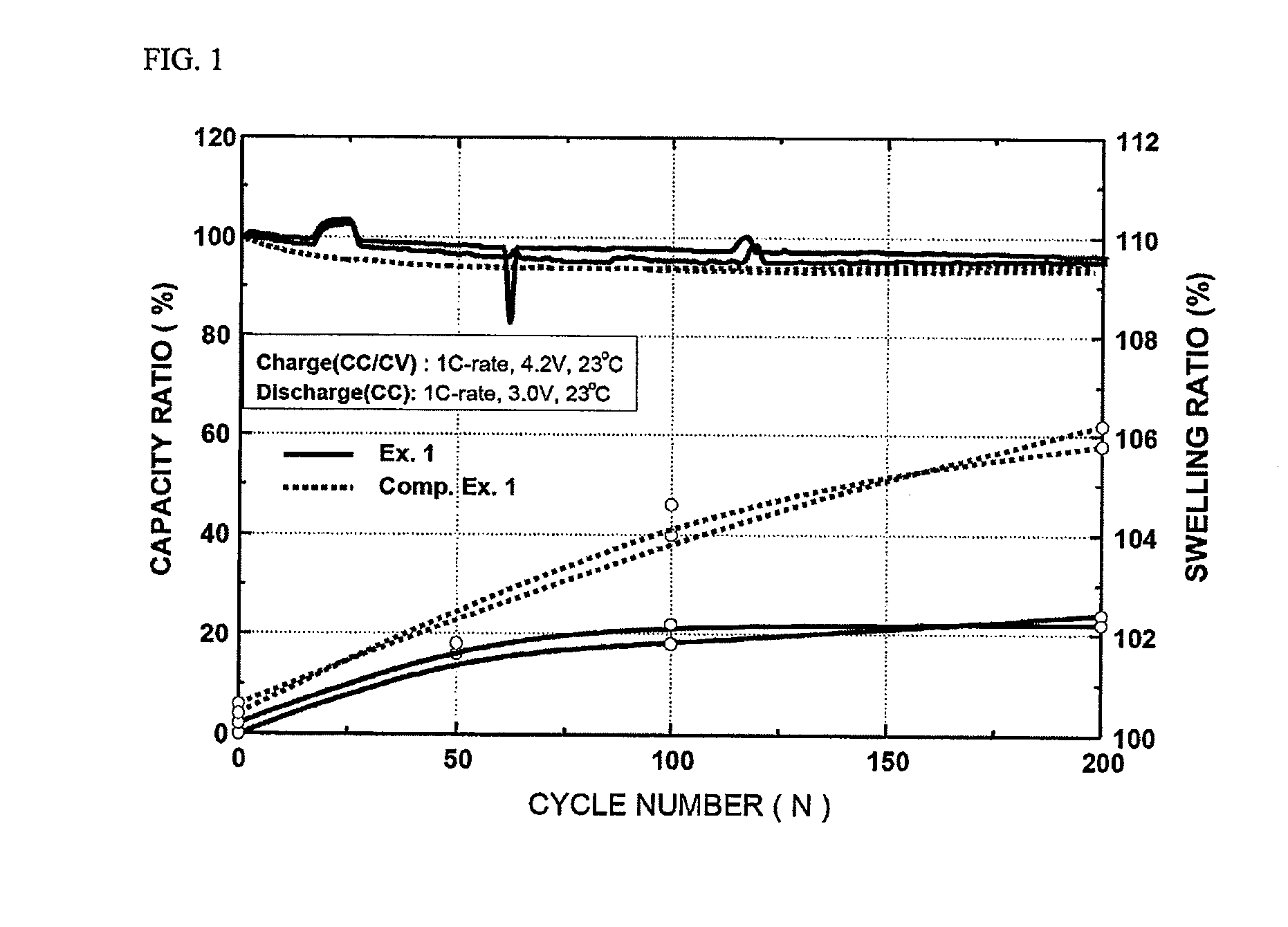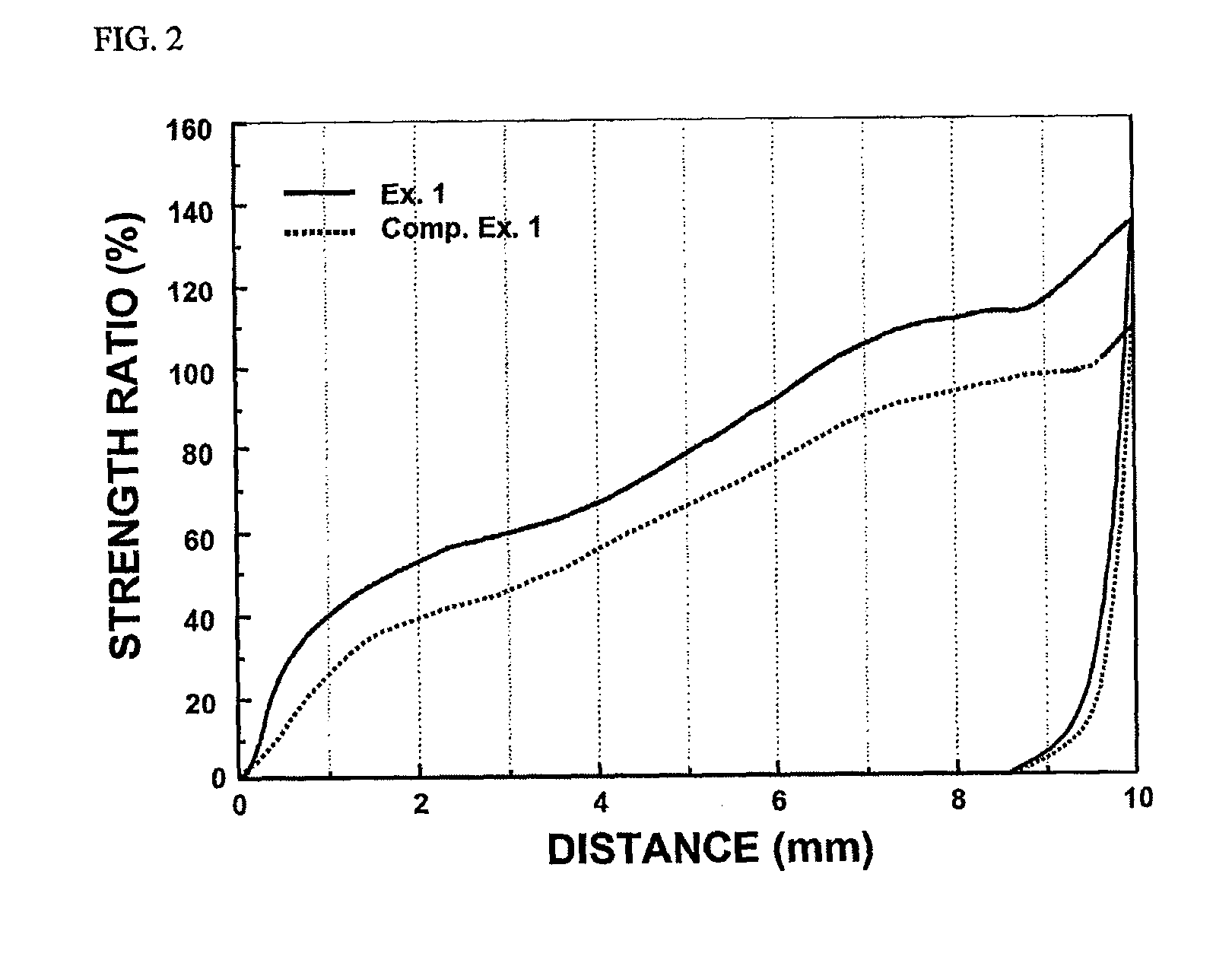Preparation process for preventing deformation of jelly-roll type electrode assembly
a technology of electrode assembly and preparation process, which is applied in the direction of wound/folded electrode electrodes, sustainable manufacturing/processing, cell components, etc., can solve the problems of lowering threatening the safety of the battery, and the electrode assembly may become deformed, so as to achieve favorable buffer effects
- Summary
- Abstract
- Description
- Claims
- Application Information
AI Technical Summary
Benefits of technology
Problems solved by technology
Method used
Image
Examples
example 1
1.1. Preparation of Electrode Sheet
[0083]A cathode sheet was fabricated by adding 95 wt. % of lithium cobalt oxide (LiCoO2) as a cathode active material, 2.5 wt. % of Super-P (a conductive material), 2.5 wt. % of PVdF (a binder) to N-methyl-2-pyrrolidone (NMP) as a solvent to prepare a cathode mixture slurry, and then, applying the slurry to both sides of an aluminum foil, drying and compressing the same.
[0084]An anode sheet was fabricated by adding 95 wt. % of graphite as an anode active material, 1.5 wt. % of Super-P (a conductive material), 3.5 wt. % of PVdF (a binder) to NMP to prepare an anode mixture slurry, and then, applying the slurry to both sides of a copper foil, drying and compressing the same.
1.2. Preparation of Organic / Inorganic Composite Porous Membrane
[0085]An organic / inorganic composite porous membrane was fabricated by the following procedure. Firstly, 5 wt. % of polyvinylidenefluoride-chlorotrifluoroethylene (PVdF-CTFE) copolymer was added to acetone as a first s...
experimental example 1
[0089]In order to compare and determine differences in cycle characteristics and swelling properties of two batteries fabricated in Example 1 and Comparative Example 1, respectively, 500 charge / discharge cycles were conducted under charge / discharge conditions shown in FIG. 1 and capacity ratios and swelling extents were determined. The results are shown in FIG. 1.
[0090]As illustrated in FIG. 1, it was found that the battery fabricated according to Example 1 has cycle characteristics substantially corresponding to those of the battery fabricated according to Comparative Example 1. More particularly, both of the batteries of Example 1 and Comparative Example 1 substantially maintained the same discharge capacity. Therefore, it may be understood that the present inventive battery of Example 1 exhibited no decrease in discharge capacity, although it had a separation membrane having an organic / inorganic composite layer.
[0091]On the other hand, a swelling ratio of the battery of Example 1...
experimental example 2
[0092]In order to evaluate a mechanical strength of a battery, the batteries fabricated in Example 1 and Comparative Example 1 were subjected to bending strength measurement (using a texture analyzer) so as to determine a piercing strength. The results are shown in FIG. 2.
[0093]As illustrated in FIG. 2, the present inventive battery of Example 1 exhibited greater than 30% higher strength than the battery of Comparative Example 1. The reason behind these results may be that the mechanical strength of the battery was improved by inorganic particles in the organic / inorganic composite coating layer.
[0094]Although the preferred embodiments of the present invention have been disclosed for illustrative purposes, those skilled in the art will appreciate that various modifications, additions and substitutions are possible, without departing from the scope and spirit of the invention as disclosed in the accompanying claims.
PUM
| Property | Measurement | Unit |
|---|---|---|
| interfacial friction coefficient | aaaaa | aaaaa |
| particle diameter | aaaaa | aaaaa |
| diameter | aaaaa | aaaaa |
Abstract
Description
Claims
Application Information
 Login to View More
Login to View More - R&D
- Intellectual Property
- Life Sciences
- Materials
- Tech Scout
- Unparalleled Data Quality
- Higher Quality Content
- 60% Fewer Hallucinations
Browse by: Latest US Patents, China's latest patents, Technical Efficacy Thesaurus, Application Domain, Technology Topic, Popular Technical Reports.
© 2025 PatSnap. All rights reserved.Legal|Privacy policy|Modern Slavery Act Transparency Statement|Sitemap|About US| Contact US: help@patsnap.com


